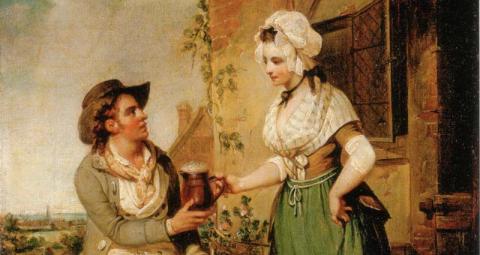"Brewing", "herbs," "broomsticks," "woman." When one hears these words together, most often the assumption is that the person in question is a witch. Yet brewing has another meaning - one that revolves around the avarice of alcohol. Alewives were women in the Middle Ages through the early modern period who brewed and sold alcohol. Due to the alewives' skills in the kitchen, fashion sense, and the eventual rise of urban guilds, however, the alewife soon became a term synonymous with "witch."
Brewing belonged to women from the medieval to early modern periods for a variety of reasons. The most obvious is the fact that women were tasked with kitchen chores, and brewing required many of them. Women kept the kitchen in order, made dough and baked bread; they planted and grew herbs, ground grains, and boiled ingredients in a large black cauldron over a sweltering fire for stews. The practice, therefore, was rather economic for women to undertake.
They already possessed the skills and tools needed to begin make ale and beer. Furthermore, as there was no shortage in the need for alcoholic beverages, the process was beneficial to the family of the brewer as well. In addition to selling ale in public spaces, the households of these alewives were known to take on secondary roles as alehouses, where the women brewed and sold their product in spaces akin to bars or taverns.
Now, briefly consider the aforementioned points outside the economic benefits: a woman, single or widowed in a time when being husbandless was considered taboo, working over a hot, black cauldron while young children gathered her ingredients. The woman toiled over her bubbling brew, a thick mixture of natural ingredients that, after fermentation, would eventually create a drink that could cause any man to lose total control if he overindulged. Such a creation sounds more than a little bit like a magical potion, does it not?
Add in the fact that women who chose to run alehouses put themselves in a public space, exposing their brewing process to all who came through their doors. Suddenly, there appears to be visual evidence of some sort of magical workshops—at least, that was what the Church and male-run guilds claimed by the early modern period. The broomstick typically associated with witchcraft was also equally associated with alewives. A broom hung over the front door of a home indicated that the house was a seller of beer and ale, or an alehouse with alcohol available.
The physical appearance of witches was similarly inspired by the garb of alewives who chose to sell their products in marketplaces. Women in the early modern period often wore large conical black hats —the very same that children wear on Halloween nowadays. These hats were part of the period fashion, however, and were indicative of high-born ladies, allowing these women to be recognized for their social class from afar. Brewers adopted the habit (and some were well-off anyway) as a method by which to easily sell their product in crowded streets and public squares. Look for the black hat, and you'll find yourself an alewife with product to sell!
By Ryan Stone




